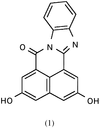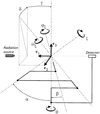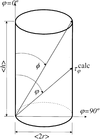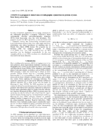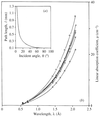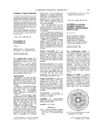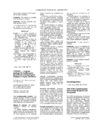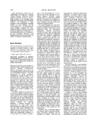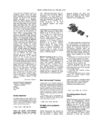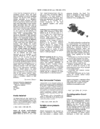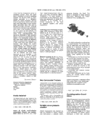issue contents
April 1999 issue

Cover illustration: Simulated diffraction pattern for a two-dimensionally disordered decasil (porous SiO2) calculated using a fast recursive algorithm. The plane is perpendicular to c with the reciprocal index l = 1; the error probability is 0.5 and the intensities are scaled to 25% of the highest value. Courtesy of Peter Daniels.
research papers
The effect of miscut on the intensity and direction of X-ray crystal truncation rod (CTR) scattering is presented for both simple cubic and diamond cubic lattices. Data collection schemes are presented for correctly measuring the CTR intensity of a crystal with miscut.
The contrast of white-beam stroboscopic synchrotron topographs of Rayleigh waves induced by a piezoelectric transducer in an α-quartz crystal is analysed. A periodic optimal thickness is found that maximizes the film contrast.
Use of the recently developed polycapillary optics technology to collimate and focus X-ray beams provides significant benefits, including increased signal, high-energy background rejection and convenience of alignment, for diffraction with spatial resolution of the order of tens of micrometres or from small samples.
A new algorithm for Cu Kα2 elimination is presented based on the Cu Kα emission spectrum obtained by monolithic double-crystal spectrometer measurement.
Synchrotron X-ray single-crystal diffraction has been used to study the pressure-induced sequence of phase transitions in potassium sodium fluoromanganate.
The crystal structure of the yellow pigment C18H10N2O3 was determined from powder data by a combination of energy minimizations and rigid-body Rietveld refinement.
In situ white-beam synchrotron radiation topographic observations under an electric field have been made on the KTiOPO4 family of crystals. The quasi-one-dimensional conductivity is a governing factor in the explanation of the field-related phenomena.
A normal-beam equatorial four-circle diffractometer with no restrictions on its  (equivalent to
(equivalent to  of Eulerian cradle and to
of Eulerian cradle and to  of a
of a  cradle),
cradle),  and
and  axes is described. The mathematical formalism eliminates possible misalignments of the goniometer axes.
axes is described. The mathematical formalism eliminates possible misalignments of the goniometer axes.
The generalized indirect Fourier transformation method is a new technique for the evaluation of small-angle scattering data from semi-dilute or dense systems. In this contribution, the influence of polydispersity is considered by using an effective structure factor.
Computer algorithms for the topological analysis of experimental electron densities, mapping of the gradient and Laplacian, and search and analysis of the critical points are presented.
A method to determine experimental P–V–T data and to correct misalignment of diffraction optics using thermoelastic equations of state of multiple phases is presented. This technique is crucial for experiments conducted under the extreme conditions of high pressures, high temperatures and dynamic reactions.
The grazing-incidence small-angle X-ray scattering (GISAXS) technique was used to analyse the morphological structure of a C–Ag co-sputtered thin film depending on the depth. A comparison of the results with those for C/C–Ag and Ag/C thin films is presented.
Structural characterization of metallic clusters in ion-implanted glasses using synchrotron radiation grazing-incidence X-ray diffraction is reported.
The crystalline and microstructure of some phases of the pseudobinary AlN–Al2O3 system are discussed, with special attention to the γ spinel phase. X-ray and neutron diffraction Rietveld peak-profile refinement data have been employed in the analysis of different hypotheses of the structures.
Results from the crystalline and microstructure study of the φ′ and δ-AlON spinel phases by X-ray diffraction, neutron diffraction and standard-resolution transmission electron microscopy techniques are reported. A structural model is proposed to account for the double modulation of conformation and displacement of the cations and anions for the two phases.
Size distribution and aggregation of particles in ferrofluids were quantitatively determined by means of small-angle scattering.
A model is developed for anisotropic peak broadening in powder diffraction spectra based on the moments of the multi-dimensional distribution of lattice metrics. The technique is illustrated with two examples: sodium p-hydroxybenzoate and rubidium fulleride.
Anisotropic strain broadening in a cubic Li–Mn spinel has been interpreted by the dislocation model of the mean-square strain. Combination of this dislocation model with the Fourier coefficients method enabled excellent whole powder-pattern fitting.
Diesel waxes crystallize in one of two orthorhombic space groups:  (low disorder) or Fmmm (high disorder). From the 00l spacings it is possible to calculate the extent of voids in the wax crystals.
(low disorder) or Fmmm (high disorder). From the 00l spacings it is possible to calculate the extent of voids in the wax crystals.
A method is developed for precise evaluation of pole density and secondary extinction in films. Its validity in general covers all fine-crystalline textures, whatever their origin.
The diffuse intensity distribution of X-rays scattered from a dipolarly disordered single crystal of 2,3-dimethylnaphthalene has been measured. Correlation coefficients characterizing the mean mutual orientation of neighbouring molecules were determined.
Quantitative treatment for extracting coherent elastic scattering from X-ray scattering experiments
A procedure for separating the inelastic and elastic contributions to the total scattering in high-energy scattering experiments is described. The procedure uses curve fitting of energy-dispersive X-ray spectra and is applied to scattering from amorphous silicon.
teaching and education
Free 

The software described uses animations and interactive programs to teach crystal growth, plane- and space-group symmetry elements, unit cells and asymmetric units, reciprocal space, precession photographs and an introduction to reading the International Tables for Crystallography.
short communications
Correlation, with a two-dimensional Gaussian function, was used to locate the positions of diffuse peaks in X-ray diffraction patterns of oriented collagen. The centre of each pattern was found by convolution with a two-dimensional Gaussian function.
A rational strategy and a computer program to discern the solubility properties of a macromolecular sample are presented. The method uses the most popular crystallization screening kits.
computer programs
EXPO is a program for full powder pattern decomposition, crystal structure solution and phase refinement.
A new version of the program VALMAP for drawing contour maps using the bond-valence-sum method is presented.
Complicated analyses of X-ray powder diffraction peak shape on the bases of peak fitting, the Voigt method and the Williamson–Hall plot are implemented in the form of user-friendly dialogues into an MS-DOS program. The tools are used for the estimation of apparent (X-ray) crystallite size and lattice strain, as well as the calculation of actual dimensions of crystallites, assuming spherical or cylindrical shape.
A computer program for the display of intensity data as simulated precession photographs is described.
A computer program for the display of cross-sectional slices through a unit cell is described.
UMWEG-XX is a software tool for taking into account multiple diffraction effects in crystal structure analysis.
A program has been written to convert X-ray diffraction data, generated by Siemens and INEL detectors, to reciprocal space. The application of the program to diffuse scattering in Al-doped YBCO superconductor and WO3 is presented.
A computer program to detect non-crystallographic symmetry in protein crystals from heavy-atom sites is presented. The program has been successfully applied in the determination of at least eight protein structures.
laboratory notes
The design of in situ electrochemical cells for X-ray absorption and diffraction studies requires attention to the window material. X-ray absorption values are calculated for a range of common polymer window materials.
A modified design for zero-scaling pressure cylinders for neutron powder diffraction is described. It allows the elastic pressure capability of the cylinders to be increased.
computer program abstracts
Some crystallographic software utilities in the form of Java applets are presented.
A program to simulate precession photographs is presented.
CRITXPL is a program for presenting graphically the variation of the criteria during an X-PLOR refinement.
The basic resources of the program package TOPOS intended for the automation of crystal-chemical analysis are described.
crystallographers
Free 

book reviews
Free 

books received
Free 

Free 

Free 



 journal menu
journal menu














